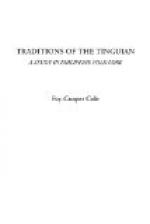In one corner of the living room is a box containing blankets, above which are pillows and mats used by members of the household and guests; an iron caldron lies on the floor, while numerous Chinese jars stand about. A hearth, made up of a bed of ashes in which stones are sunk, is used for cooking. Above it is a bamboo food hanger, while near by stand jars of water and various cooking pots. Food baskets, coconut shell cups, and dishes, and a quantity of Chinese plates appear when the meal is served, while the use of glass is not unknown. Cups of gold, wonderful jars, and plates appear at times, but seem to be so rare as to excite comment (pp. 33, 98, 102, 105).
Scattered through the village are numerous small buildings known as balaua (p. 43), which are erected for the spirits during the greatest of the ceremonies, and still inside the enclosure are the rice drying plots and granaries, the latter raised high above the ground so as to protect their contents from moisture (p. 150).
About the town pigs and chickens roam at will, while half-starved hunting dogs prowl about below the kitchens and fight for morsels which drop from above (p. 99). Carabao are kept and used as food (p. 101), but in the cycle proper no mention is made of using them as work animals. [8] Game, especially deer and wild chickens, and fish are added to the domestic supply of food (p. 80), but the staple appears to be mountain rice. Beans, coconuts, oranges, sugar cane, betel-nuts, and tobacco are also cultivated (pp. 33, 107, 121, 138).
Clothing is scanty but nevertheless receives much attention. The poorest of the men wear clouts of banana leaf, and the women, when in danger of capture, don skirts of bark; but on most occasions we find the man wearing a colored cotton clout, above which is a bright belt of the same material, while for ceremonies he may add a short coat or jacket. A headband, sometimes of gold, keeps his long hair in place, and for very special events he may adorn each hair with a golden bead (pp. 74, 76, 81).
The cotton skirts of the women reach from the waist to the knees; the arms are covered with strands above strands of beads, while strings of agate beads surround the neck or help to hold the hair in place. To the real hair is often added a switch which appears to be valued highly (p. 89). Ornaments of gold adorn the ears, and finger rings of the same metal are several times mentioned (pp. 39, 43, 124).
The tales afford us a glimpse of the daily life. In the early morning the chilly mountain air drives the people from their mats to the yard, where they squat about the fires (p. 132). As it becomes light, part of the women begin pounding out the rice from its straw and husks (p. 144), while others depart for the springs to secure water (p. 101). In planting time husband and wife trudge together to the fields, where the man plants the seeds or cuttings, and his wife assists by pouring on water (p. 107).




